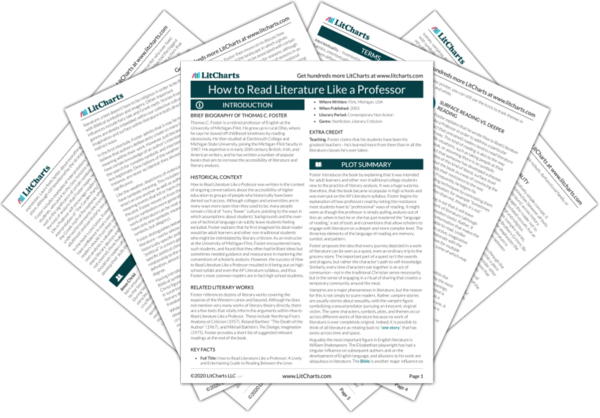Summary
Analysis
Foster says that if you’re wondering whether something in a piece of literature is a symbol, it’s pretty safe to say that yes, it is. What’s rarely clear is the exact symbolic meaning. In fact, symbols that only have one specific meaning aren’t technically symbols at all, but allegories. George Orwell’s Animal Farm (1945) is a good example of an allegory; it’s clear that Orwell hopes to convey one specific message about the nature of political power and revolution, a message that message is hidden behind the novel’s farmyard setting.
An allegory is a text (or image) that has a hidden meaning beyond the story being told on the surface. Although this is similar to a symbol, the important distinction is that allegories have a single meaning that the reader (or viewer) is supposed to discover. Allegories are not designed to produce multiple interpretations that people will argue over, but rather to lead the reader through clues to find the one “true” meaning.
Themes
Symbols, on the other hand, remain open to multiple possible interpretations. In E.M. Forster’s A Passage to India (1924), an alleged assault takes place inside a cave. What does the cave symbolize? Early humans lived in caves, and it’s possible the cave points to a sense of primitivism. But caves are also dark, and thus the cave could represent the (sometimes frightening) mystery of our inner consciousness. If the cave is empty, it might symbolize the Void, the eerie sense of nothingness that has the tendency to fill people with a sense of existential dread. The cave is also in India, and the woman who thinks she was assaulted within it is white, suggesting that the cave might have racial connotations. Ultimately, whichever reading of the cave most appeals to us is likely the result of the individual background we have as readers.
As Foster argues throughout the book, contrasting interpretations of literature are not a negative thing. Rather, they are productive and stimulating, and can make literature seem richer, more sophisticated, and more challenging. It would be possible to argue that the cave in A Passage to India betrays several of the meanings Foster lists at once; however, generally literary criticism seeks to identify a single interpretation that the critic finds most interesting, resonant, or convincing.
Themes
Even when it seems likely that a given symbol will have a fixed, consistent meaning, this is in fact rarely the case. Mark Twain, Hart Crane, and T.S. Eliot are all male Midwestern authors who, despite coming from different generations, were at one point all alive at the same time. All three feature rivers in their writing—and yet in each case, the river takes on a completely different meaning. This is not to say that there is never any overlap or intertextual resonance, but that a river in one work can have a totally distinct and contradictory meaning from the same river in another.
Here Foster identifies one method of deducing meaning from a work of literature—considering historical context and intertextual connections—while showing that this method can be limited. After all, relying on historical connections alone might have us believe that Twain, Crane, and Eliot were interested in exploring the same ideas or themes in their work, when in fact this is not the case.
Themes
Foster admits that his favored method of literary analysis tends to emphasize the historical context in which a piece of literature was written—this is called a historicist reading. However, this is only one method, and should not be taken as definitive; indeed, the clashes between contrasting interpretations are a positive quality of literary analysis, and Foster encourages readers to take pleasure in disagreement.
While it may seem logical to always take into account the historical context of a work of literature, there is in fact a strong backlash against this interpretive technique. Most famously, the New Criticism movement argued that texts should be considered simply as they are, independent of any context.
Themes
Get the entire Read Like a Professor LitChart as a printable PDF.

Readers often assume that only objects can be symbols, but actually, so can actions and events. The poet Robert Frost is “probably the champion of symbolic action,” centering poems around the symbolism of acts such as mowing a field with a scythe (“Mowing” (1913)). In this instance, the particular act of mowing stands for labor more generally, or solitary action, or perhaps something else entirely.
As the example of Frost’s poem “Moving” shows, the symbolic meaning of a symbol doesn’t have to be wildly different from its surface-level meaning. Indeed, the act of mowing and concepts such as solitary action or labor are clearly deeply connected.
Themes
Foster advises readers to avoid making definitive statements about symbolic meaning, but also to trust their existing knowledge of literature as well as their instincts when it comes to figuring out what a given part of a text might symbolize. Although readers shouldn’t invent meaning out of thin air, the act of reading is nonetheless an active, imaginative exercise, and we shouldn’t be afraid to be creative in our experiments with interpretation.












